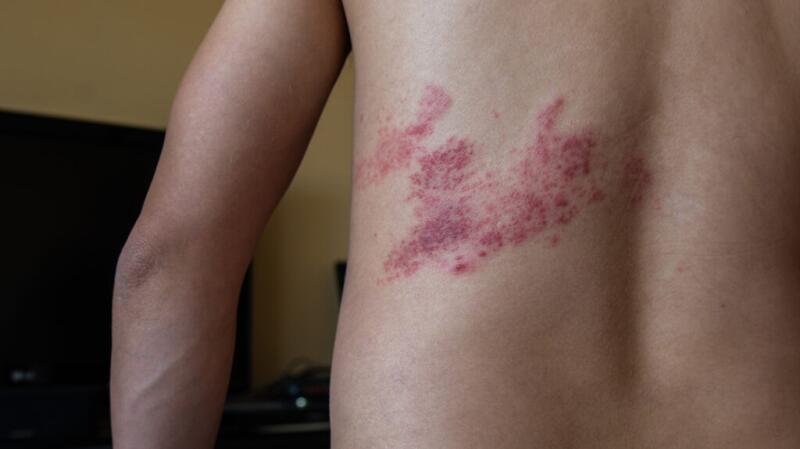Shingles is a viral condition that results in a rash or blisters on the skin. The varicella-zoster virus causes it and chickenpox. Once you have chickenpox, the virus stays in your body. It may be inactive for many years and then reactivates and causes shingles as you get older.
Although there is no cure for shingles yet, there are medications that can help make symptoms less severe and help you recover more quickly. Your doctor can also recommend medications to help with pain and home treatments to manage itching.
Even if you have had shingles, you can get a shingles vaccine to help prevent future outbreaks.
This article provides details about shingles, including what causes it, symptoms, complications, and how you can prevent shingles.

Shingles is a painful condition caused by the reactivation of the varicella-zoster virus, the same virus that causes chickenpox. Shingles, also called herpes zoster, attacks nerve cells and causes severe nerve pain and a skin rash that appears over the affected nerve.
Shingles develops in people who had chickenpox. The varicella-zoster virus can remain in the body in an inactive form for years. In some people, the dormant virus reactivates later in life by something that stresses the immune system, such as an illness.
A person cannot get shingles through contact with a person who has it. However, a person who never had chickenpox can get chickenpox from a person with shingles through direct contact with the shingles rash.
Shingles is most common in older adults who have had chickenpox. Shingles is preventable

Shingles produces a red or discolored, blistering rash. The rash occurs in a band or strip and typically occurs along one side of the body, including:
- chest
- abdomen
- back
- face or neck
- scalp
- arm or leg
Symptoms of shingles affect the nerves and the skin. Shingles can occur in almost any part of the body, but
Common symptoms of shingles
The most
- sensation of an itching, tingling, or severe burning or shooting pain that precedes a rash
- painful rash in a band or patch-like shape over the affected area
- fluid-filled blisters that eventually dry out, crust over, and heal
Other symptoms may include chills, upset stomach, fever, and headache.
Serious symptoms that might indicate complications of shingles
In some cases, shingles can affect the nerves of the face, eyes, or ears and cause serious symptoms and complications, such as facial paralysis or impaired vision and hearing. Get prompt medical care if you, or someone you are with, have symptoms of shingles, particularly the following symptoms or conditions:
- decreased or double vision
- painful, widespread rash, a symptom of disseminated shingles
- weakened immune system caused by a chronic condition or immune-suppressing medications
- rash near your eyes or involving the tip of the nose
There are no formal, clinical stages of shingles, but symptoms generally fall into three stages. Beginning to end, shingles can last
Contact your doctor right away if you have symptoms of shingles. Early treatment with antiviral medication may help lessen the severity, speed recovery time, and lower the potential for complications.
Stage 1: Tingling burning skin sensations
The first stage of shingles may be marked by a burning sensation, numbness, or itchiness in the area where the shingles rash appears. This is known as the prodromal period.
Common places for the rash to develop include around the waistline, chest, or back, usually on one side of the body. It may also occur on one side of the scalp, face or neck, or on one arm or leg.
Stage 2: Rash outbreak
The second stage of shingles is an eruption of the rash itself, typically 3–4 days after you first experience the tingling and burning sensation.
The rash typically appears as a band or strap. It includes fluid-filled blisters and lasts
Some people experience a minor rash or skin irritation. For other people, the rash can cover a larger area. Flu-like symptoms may also occur at this stage.
Stage 3: Blister scab over
In the third stage, shingles blisters dry out and scab over before disappearing.
Beginning to end, shingles lasts
The same virus that causes chickenpox causes shingles. It is the varicella-zoster virus. When a person has chickenpox, the immune system eventually clears the symptoms, but the virus remains dormant in specialized nerve cells.
The virus remains inactive for years until it reactivates later in life and causes shingles.
When the virus “wakes up,” it moves along sensory nerve fibers from the central nervous system down to the nerve endings in the skin. The virus quickly multiplies, causing the characteristic blistering rash.
The risk of shingles increases with age. This is likely due to age-related general weakening of the immune system and loss of varicella-zoster virus immunity. Besides naturally waning immunity, anything that taxes the immune system, such as illness or stress, can trigger the virus reactivation.
In the United States,
Other factors that increase your risk include:
- conditions that weaken the immune system, such as HIV, cancer, chemotherapy, or an organ transplant
- weakened or impaired immune system, which also increases the risk for having recurring episodes of shingles
- recent illness
- stress
The risk of shingles is usually 10 times greater in adults who are more than 60 years old than in children younger than 10. Much of the increase in shingles risk occurs at around 50 years old.
You can lower your risk of shingles and its complications by getting the vaccine for shingles. The Food and Drug Administration
- ages 50 and older
- people 18 years and older whose immune systems are weakened or compromised by a medical condition
- people 18 years and older taking immune-suppressing medication
Shingrix is
You can reduce your risk of chickenpox and the subsequent development of shingles by avoiding exposure to a person with chickenpox and getting vaccines for both of these conditions, as your healthcare professional recommends.
People with shingles cannot pass on shingles, but they can pass on the varicella-zoster virus, which can result in chickenpox.
Shingles only occurs in someone who experienced chickenpox. A person with shingles can give chickenpox to someone who is not immune to the varicella-zoster virus, either naturally by having had chickenpox or through the vaccine.
You can pass on the varicella-zoster virus by skin-to-skin contact, such as touching the fluid from a shingles blister and then touching an individual.
If you have shingles, stay physically distant from someone who has not had chickenpox or the chickenpox vaccine, such as an infant.
There is no cure for shingles yet, but antiviral medications can lessen the severity and duration of the condition. Antiviral medications can also reduce the risk of developing postherpetic neuralgia, which is a serious nerve complication of shingles.
Antivirals are most effective within 72 hours of the first symptom of shingles. Antiviral medications include:
- acyclovir (Sitavig, Zovirax)
- famcyclovir (Famvir)
- valcyclovir (Valtrex)
Other medications that may treat shingles include:
- corticosteroids, which may reduce the risk of developing postherpetic neuralgia, although this treatment is controversial
- pain relief medications, which may include over-the-counter general pain relievers and prescription gabapentin for nerve-related pain. Your doctor can prescribe more powerful pain relievers if necessary.
- antidepressant medications to
also treat Trusted Source PubMed Central Highly respected database from the National Institutes of Health Go to source postherpetic neuralgia, shingles pain that may linger for months or even years
In some cases of shingles, including disseminated shingles or shingles complications, hospitalization is necessary to provide comprehensive medical care.
Self-care for shingles at home includes:
- applying calamine lotion or other creams to soothe the skin and relieve pain
- cleaning the rash area gently to prevent bacterial infection
- placing cool compresses on blisters to lessen pain and help the blisters heal
- drinking plenty of water and other healthy liquids
- reducing stress as much as possible, such as walking every day and eating nutritious food
- resting, contact your doctor if pain is making it difficult to sleep
Untreated shingles can lead to serious complications. People with compromised immune systems are at a
- bacterial skin infections such as impetigo
- ear pain
- facial paralysis
- meningitis or encephalitis
- permanent eye damage and impaired vision
- loss of hair over the affected area and scarring
- postherpetic neuralgia, which is shingles pain that lingers for months or even years
The risk of postherpetic neuralgia is greater in older adults and people who have severe pain with shingles. Postherpetic neuralgia can occur in
Here are some questions people often ask about shingles.
Can you get shingles more than once?
It is possible to have shingles more than once during your lifetime. Most people who develop shingles will have only one episode, but in rare cases, a person will have a second or third episode.
How long does it take for shingles to go away?
Most people have shingles over the course of
A few days later, the rash turns into blisters, which will dry up and crust over after about 7–10 days. The scabs should clear up a couple of weeks later.
Should I stay home from work if I have shingles?
According to the United Kingdom’s National Health Service, you can only pass the virus to other people while the shingles rash oozes fluid. So, be sure to cover the rash with loose clothing or a nonsticky dressing.
Shingles is a condition that causes a painful rash or blisters on the skin, usually on one side of the face or body. The varicella-zoster virus causes it, the same virus that causes chickenpox. The virus can remain inactive in the body for many years, but may reactivate and cause shingles later in life.
Many people experience itching, burning, tingling, or shooting pain before they develop a rash. The rash turns into blisters, which eventually dry out and crust over as they heal. Other symptoms of shingles include fever, chills, headaches, and an upset stomach.
Talk with your doctor about shingle symptoms. Antiviral medication can shorten the length and lessen the severity of shingles symptoms. Other medications can help with the pain, relieve itching, and allow you to feel more comfortable as your condition heals.





